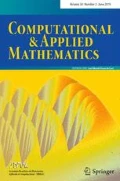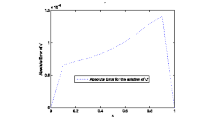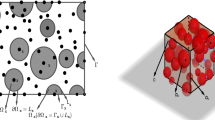Abstract
To a large extent, the stiffness of the bidomain and monodomain models depends on the choice of the ionic model, which varies in terms of complexity and realism. In this paper, we compare and analyze a variety of time-stepping methods: explicit or semi-implicit, operator splitting, exponential, and deferred correction methods. We compare these methods for solving the monodomain model coupled with three ionic models of varying complexity and stiffness: the phenomenological Mitchell–Schaeffer model, the more realistic Beeler–Reuter model, and the stiff and very complex ten Tuscher–Noble–Noble-Panfilov (TNNP) model. For each method, we derive absolute stability criteria of the spatially discretized monodomain model and verify that the theoretical critical time steps obtained closely match the ones in numerical experiments. We also verify that the numerical methods achieve an optimal order of convergence on the model variables and derived quantities (such as speed of the wave, depolarization time), and this in spite of the local non-differentiability of some of the ionic models. The efficiency of the different methods is also considered by comparing computational times for similar accuracy. Conclusions are drawn on the methods to be used to solve the monodomain model based on the model stiffness and complexity, measured, respectively, by the eigenvalues of the model’s Jacobian and the number of variables, and based on strict stability and accuracy criteria.







Similar content being viewed by others
References
Ascher UM, Ruuth SJ, Wetton BTR (1995) Implicit-explicit methods for time-dependent partial differential equations. SIAM J Numer Anal 32(3):797–823
Beeler GW, Reuter H (1977) Reconstruction of the action potential of ventricular myocardial fibres. J Physiol 268:177–210
Cain JW (2011) Taking math to heart: mathematical challenges in cardiac electrophysiology. Not AMS 58(4):542–549
Clayton R, Bernus O, Cherry E, Dierckx H, Fenton F, Mirabella L, Panfilov A, Sachse F, Seemann G, Zhang H (2011) Models of cardiac tissue electrophysiology: progress, challenges and open questions. Prog Biophys Mol Biol 104(1):22–48
Ethier M, Bourgault Y (2008) Semi-implicit time-discretization schemes for the bidomain model. SIAM J Numer Anal 46(5):2443–2468
Guermond JL, Minev P (2015) High-order time stepping for the incompressible Navier–Stokes equations. SIAM J Sci Comput 37(6):A2656–A2681
Hairer E, Nørsett S, Wanner G (1993) Solving ordinary differential equations I: Nonstiff Problems. Springer Series in Comp. Math., vol. 8. Springer, New York
Hairer E, Wanner G (1996) Solving ordinary differential equations II: stiff problems and differential-algebraic problems. Springer Series in Comp. Math., vol. 14. Springer, New York
Hanslien M, Artebrant R, Tveito A, Lines GT, Cai X (2011) Stability of two time-integrators for the Aliev–Panfilov system. Int J Numer Anal Model 8(3):427–442
Hodgkin A, Huxley A (1952) A quantitative description of membrane current and its applications to conduction and excitation in nerves. J Physiol 117:500–544
Keener J, Bogar K (1998) A numerical method for the solution of the bidomain equations in cardiac tissue. Chaos: An Interdisciplinary. J Nonlinear Sci 8(1):234–241
Keener J, Sneyd J (2004) Mathematical Physiology. Springer, New York
Kress W, Gustafsson B (2002) Deferred correction methods for initial boundary value problems. J Sci Comput 17(1–4):241–251
Marsh M, Torabi S, Spiteri R (2012) The secrets to the success of the Rush–Larsen method and its generalizations. IEEE Trans Biomed Eng 59(9):2506–2515
Mitchell C, Schaeffer D (2003) A two-current model for the dynamics of cardiac membrane. Bull Math Biol 65:767–793
Perego M, Veneziani A (2009) An efficient generalization of the Rush–Larsen method for solving electro-physiology membrane equations. Electron Trans Numer Anal 35:234–256
Puwal S, Roth B (2007) Forward Euler stability of the bidomain model of cardiac tissue. IEEE Trans Biomed Eng 54(5):951
Report 84F0209X, Statistics Canada (2009) Mortality, summary list of causes. https://www150.statcan.gc.ca/n1/en/catalogue/84F0209X
Roy T (2015) Time-stepping methods in cardiac electrophysiology. Master’s thesis, University of Ottawa, Canada
Rush S, Larsen H (1978) A practical algorithm for solving dynamic membrane equations. IEEE Trans Biomed Eng 25(4):389–392
Schroll H, Lines G, Tveito A (2007) On the accuracy of operator splitting for the monodomain model of electrophysiology. Int J Comput Math 84(6):871–885
Spiteri R, Dean R (2008) On the performance of an implicit-explicit Runge–Kutta method in models of cardiac electrical activity. IEEE Trans Biomed Eng 55(5):1488–1495
Spiteri R, Dean R (2010) Stiffness analysis of cardiac electrophysiological models. Ann Biomed Eng 38:3592–3604
Strang G (1968) On the construction and comparison of difference schemes. SIAM J Numer Anal 5:506–517
Sundnes J, Artebrant R, Skavhaug O, Tveito A (2009) A second-order algorithm for solving dynamic cell membrane equations. IEEE Trans Biomed Eng 56(10):2546–2548
Sundnes J, Lines G, Cai, X, BN, Mardal KA, Tveito A (2006) Computing the electrical activity in the heart. Springer-Verlag, Berlin Heidelberg
The finite element code CHORAL (2020). http://cpierre1.perso.univ-pau.fr/ or alternatively at https://plmlab.math.cnrs.fr/cpierre1/choral
Torabi ZS, Marsh M, Sundnes J, Spiteri R (2014) Stable time integration suppresses unphysical oscillations in the bidomain model. Comput Phys 2:40
Trangenstein J, Kim C (2004) Operator splitting and adaptive mesh refinement for the Luo–Rudy I model. J Comput Phys 196(2):645–679
ten Tusscher K, Noble D, Noble P, Panfilov A (2004) A model for human ventricular tissue. Am J Physiol Heart Circ Physiol 286:H1573–H1589
Winslow R, Scollan D, Holmes A, Yung C, Zhang J, Jafri M (2000) Electrophysiological modeling of cardiac ventricular function: from cell to organ. Annu Rev Biomed Eng 2:119
Acknowledgements
The authors would like to thank the University of Ottawa for graduate scholarships to the first author, and the Natural Science and Engineering Research Council (NSERC) of Canada for a research grant to the second author. Research exchanges between France and Canada were funded by a grant from the Agence Nationale de la Recherche of France (ANR project HR-CEM no. 13-MONU-0004-01).
Author information
Authors and Affiliations
Corresponding author
Additional information
Communicated by Jose Alberto Cuminato.
Publisher's Note
Springer Nature remains neutral with regard to jurisdictional claims in published maps and institutional affiliations.
Rights and permissions
About this article
Cite this article
Roy, T., Bourgault, Y. & Pierre, C. Analysis of time-stepping methods for the monodomain model. Comp. Appl. Math. 39, 230 (2020). https://doi.org/10.1007/s40314-020-01254-z
Received:
Revised:
Accepted:
Published:
DOI: https://doi.org/10.1007/s40314-020-01254-z




